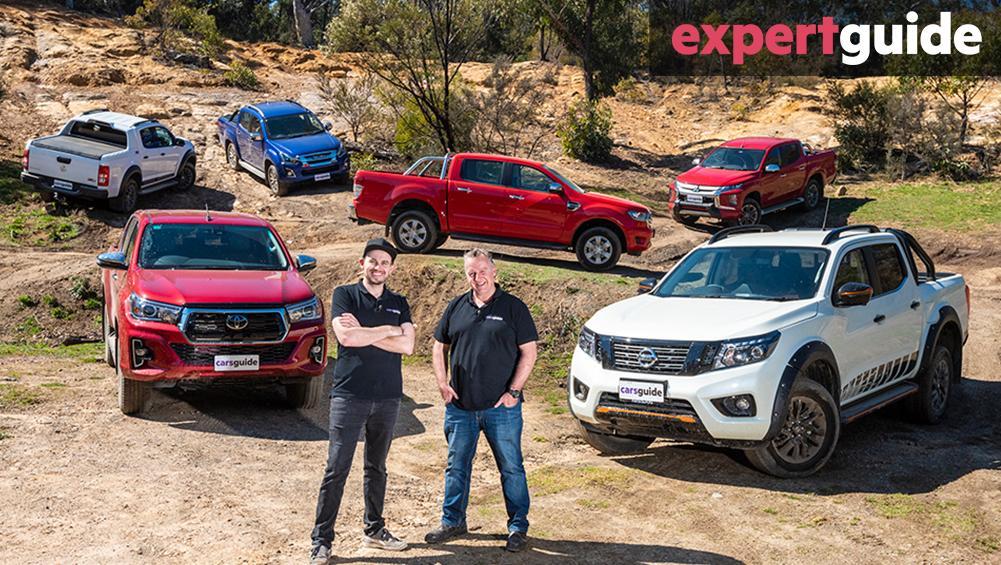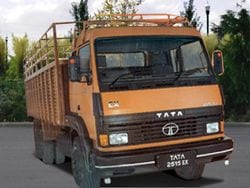
Comparative review of 4×4 Dual-Cab Ute: HiLux, Colorado, Ranger, Navara, D-Max and Triton
They are all decent off-road vehicles in their own right, so we took them out to mixed terrain to give us a clear idea of how well they would perform in harsh conditions.
Our trails included gravel, deep ruts, mud pits, rocky climbs and more. Each car here is all-wheel drive with a reduction transfer case.
The Colorado Z71 has a limited-slip differential, while the rest have a differential lock, except for the D-Max. We avoided using a differential lock to keep the playing field as level as possible.
They all seem close enough to each other in terms of off-road capability - well, at least on paper - but as is often the case, the real world can shake expectations. Here are the specifications you need to know:
| Ford Ranger XLT Bi-turbo | Holden Colorado Z71 | Isuzu D-Max LS-T | Mitsubishi Triton GLS Premium | Nissan Navara N-Trek | Toyota Hilux SR5 | |
| Angle of entry | 29 | 28.3 | 30 | 27.5 | 33.2 | 30 |
| Departure angle (degrees) | 21 (to hitch) | 23.1 | 22.7 | 23 | 28.2 | 20 |
| Tilt angle (degrees) | 25 | 22.1 | 22.3 | 25 | 24.7 | 25 |
| Ground clearance (mm) | 237 | 215 | 235 | 220 | 228 | 216 |
| Ship depth (mm) | 800 | 600 | Not specified | 500 | Not specified | 700 |
| All-wheel drive system | Selectable all-wheel drive | Selectable all-wheel drive | Selectable all-wheel drive | Selectable all-wheel drive | Selectable all-wheel drive | Selectable all-wheel drive |
| Rear differential lock | Electronic blocking of differential | Electronic blocking of differential | No | Yes | Yes | Yes |
| Limited slip differential | No | Yes | No | No | Yes | No |
| Power steering | Electric guitar | Гидравлический | Гидравлический | Гидравлический | Гидравлический | Гидравлический |
| Turning circle (m) | 12.7 | 12.7 | 12.0 | 11.8 | 12.4 | 11.8 |
| Off-road driving modes | No | No | No | Snow/mud, gravel, sand, rock | No | No |
However, it should be noted that all of these cars were on standard road tires and standard suspension, which was far from an ideal combination for rough terrain.
Each ute is listed below from best to worst.
It may come as a surprise to some that the HiLux SR5 tops this list as the most capable SUV.
HiLux has a lot of fans and a lot of haters, but its ability to overcome rough terrain is simply impressive. Its level of sophistication and comfort never approaches those of the Ranger when riding cross-country, but it always feels at its most capable.
It has never been the most perfect device, but the HiLux makes up for it by being an all-around reliable and capable device. And while it doesn’t have the highest torque here at 450Nm (the Ranger and Z71 have more at 500Nm), the HiLux has the feeling that it always uses all its torque at the right time.
Wheel slip was minimal on our standard rocky hill climb, and the SR5 generally always shows good linear throttle progression.
Hill Descent Control and Engine Braking work together to provide a stable and safe speed on steep and steep descents.
There are serious issues with Toyota's diesel particulate filter, and the HiLux suspension consistently delivers a hard ride - though not grotesque - but with bush-ready downshifts, a docile turbodiesel engine, and an incredibly efficient 4WD setup. ute once again proved its superiority off-road.
The next best was the Ranger, combining comfort and capability.
Its tires regularly let it down without grabbing the ground at critical points on short sections of steep climbs, but its suspension is always supple and its quiet and efficient terrain electronics always do a great job of being highly efficient and not intrusive at all.
The hill descent assist works at a nice regulated constant speed and you always feel in control when driving the Ranger.
It handled everything with a controlled and steady pace - its 2.0-litre twin-turbo engine never feels under pressure - and it also had better steering: consistently well-weighted even at low speeds.
For such a large unit, the largest of which weighs 2197 kg, the Ranger is always easy to maneuver on the tracks.
Cons: The Ranger is a lot better than its tires - it's the first thing you'd figure out - and it was a little awkward to get out of 4WD Low mode.
But while it had a lot of positives, the Ranger often feels a step or two removed from the actual driving experience - and here it wasn't the most capable 4WD.
Third in performance here, the Navara N-Trek is rugged and reliable, but nothing special.
It's light (the lightest here at 1993kg) and bold, and the N-Trek handles climbs and descents well - with controlled steady momentum as well as group-leading entry and exit angles (33.3 and 28.2 degrees, respectively).
In addition, its suspension was quite impressive at low and high speeds, smoothing out any sharper bumps in the terrain - even if we deliberately drove into them with a fair amount of gusto.
In terms of steering, it's never been as lively as the Ranger, but it's not as heavy as the D-Max either. It takes a little more effort to keep him on the right track than it does to get some of the utes pointed in the right direction.
Yes, it’s a bit noisy – that twin-turbocharged four-cylinder is a bit too raspy at low speeds – and sure enough, you had to work a little harder to ride the N-Trek than some other bikes. but it is certainly capable.
Next up is the Triton, which remains one of the quietest workhorses in the world.
I am a big fan of the Mitsubishi Super Select II 4X4 system and it did not disappoint me with its efficiency and ease of operation.
Even when deliberately driving the wrong way up and down rocky hills, the Triton handled everything with minimal effort. Mostly. (I say "mostly" because at some point the descent control system cut off and "ran away" a bit. Perhaps my boot slipped and pressed the gas pedal, thus knocking it out of the set speed, but I will never admit to this..)
Overall, it's pretty tuned up, but it had to work a little harder than some of the others here - just a little bit - and just didn't feel as put together as the Navara and Ranger, or as capable as the HiLux.
Not far behind is the Colorado Z71, which was "about 50 times lighter than the D-Max on the climb," as I said, according to a colleague's notes.
“It is much better when they are baptized,” said the same colleague.
We spun the tires a bit at the top of the climb, but overall the Z71's engine and electronics were better than the D-Max.
The steering is also a big improvement over the D-Max as it is more direct.
On our first descent, we had some issues with the hill descent control - it wouldn't engage - but the second time it was much more controlled - keeping our speed around 3km/h on a short, steep section.
The Z71's suspension didn't absorb bumps as well as some others in this crowd.
Last but not least is D-Max. I don't mind D-Max; There's a lot to like about his straight forward approach to getting the job done, but the fact is that sometimes he doesn't get the job done, especially if the job involves hard off-road, and if he does get the job done, he has a harder time than his competitors.
It worked the hardest in the range on climbs and descents, which I found to be light to moderate, making it uncomfortable to pilot.
His handlebars were heavy - he felt heavy, he felt every ounce of his weight - the engine was noisy, he sometimes struggled for traction on climbs and lost momentum control on descents.
On the plus side, while the 3.0-litre D-Max engine is a little noisy and not the most torquey here, it's still a decent walker, and this car's suspension was pretty good, soaking up serious potholes and ruts, even at low speeds.
All of these vehicles can be quickly converted into much more efficient SUVs with better tires, aftermarket suspension and differential locks (if not already installed).
| Model | Account |
| Ford Ranger XLT Bi-turbo | 8 |
| Holden Colorado Z71 | 7 |
| Isuzu D-Max LS-T | 6 |
| Mitsubishi Triton GLS Premium | 7 |
| Nissan Navara N-Trek | 8 |
| Toyota Hilux SR5 | 9 |
